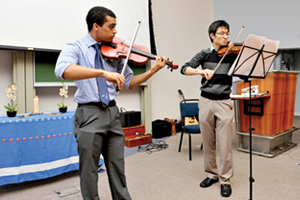Poignant tribute to cadavers
18 November 2013 | Story Helen Swingler. Photo Raymond Botha.
One of the Health Sciences faculty's more poignant ceremonies is the annual second-year MBChB tribute to the cadavers they dissect - and to the loved ones of those who donate their bodies to the cause of anatomical learning.
One of the first cadavers dissected at UCT's fledgling anatomy department at the South African College (UCT's forerunner) in 1911 was the body of a 29-year-old convict who'd been hanged for the murder of a merchant hatter in Rosebank.
Although Roeland Street Gaol was close to the Hiddingh Campus, which housed the medical school, there appear to be no other incidences of prisoners being used for dissection at UCT, said Dr Charles Slater, senior lecturer in anatomy in the Department of Human Biology.
Today, many bodies are bequeathed to the medical school; others are the unclaimed bodies of the homeless, paupers and prisoners, "those who lost their identities through what life threw at them", said Professor Graham Louw of the Department of Human Biology .
At the end of the year, each cadaver's remains are placed in a coffin and cremated separately, and the ashes are returned to those families who request this service.
"Usually the bones are kept for teaching purposes, and sometimes body parts are kept for making teaching dissecting specimens," said Slater. "These parts are meticulously tagged and can be traced to the donor."
A special team of departmental staff supervised by Bruce Dando prepares the bodies for dissection.
"When a cadaver arrives, either as a donor or a pauper, we check that it is suitable, ensure that the documentation is correct, and then prepare it for embalming. This is done using a formula of chemicals that include formalin and phenol," said Dando.
Some parts may be retained for teaching and can last for several years. With an eye on the future, UCT has funded the installation of a Plastination plant to replace the embalming fluid in cadavers with silicones.
"This means that the specimen may last for hundreds of years, alleviating the need to constantly replace embalmed specimens for teaching," added Dando.
Dando has attended conferences and workshops in Germany at Gunther von Hagens' Body Worlds factory for training, and is now training a technical officer at UCT. Von Hagens invented the Plastination process in the late 1970s, and his work is renowned.
At the cadaver ceremony on 1 November, the students recited poems of appreciation, sang songs of gratitude and performed duets of thanks. "We need to remind ourselves," said Professor Laurie Kellaway, head of the Department of Human Biology, "that the deceased were loved, and have families who miss them."
Speaking at the ceremony, Donna, whose father donated his body, said her daughter had qualified as a doctor at UCT last year. Her father was fascinated that the cadaver his granddaughter's group had dissected belonged to a 105-year-old man.
The group had named him Fred.
When he contracted terminal cancer he told the family: "I want to be like Fred."
"Today, my dad would be dancing," Donna told the assembly in the New Learning Centre. "He is where he wanted to be, thanks to you." Ben said his father, a body donor, had the gift of giving; to his family, spouse and community. "And in his death he's given to you," he told students. "Thank you that you can give back." Sue said her late husband of 47 years, also a donor, would have loved the ceremony. "And I'm sure he would have loved the name you gave him.
"We were organ donors but getting a bit long in the tooth. We thought no-one would want our 'bits'. When he got cancer, we thought, we can do this [donate his body].
Sue concluded with the observation: "If you go out as doctors expressing the empathy you've expressed here today, you'll all be wonderful." One group had named their cadaver Pappa, and another had used Umfundisi (isiXhosa for 'teacher' or 'priest') because of all the body had taught them.
"It's an important day," remarked Kellaway, "and a dignified occasion where you show gratitude for the gift of the human body, your cadaver, your teacher."
 This work is licensed under a Creative Commons Attribution-NoDerivatives 4.0 International License.
This work is licensed under a Creative Commons Attribution-NoDerivatives 4.0 International License.
Please view the republishing articles page for more information.







